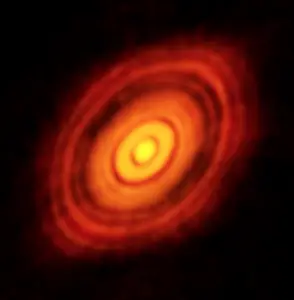
Approximately how long does it take for a planet to be born?
Is a planet currently forming and if there is, what is its name?
To answer how long it takes for planets to form, we first need to have a look at how planets are formed. The formation of planets is very closely related to star formation. Forming from collapses of clouds of gas and dust, newly formed stars are surrounded by rotating disks, similar to the way Saturn is surrounded by its rings. What’s different is that disks around young stars can be as heavy as a few percent of the star’s mass, and they are made of materials very similar to what’s in the star. If a disk around a star is heavy enough, gravity can cause the disk to fragment and collapse into planets. Gravity is really strong, so planet formation through this process can be relatively fast (thousands to tens of thousands of years). Heavy gaseous planets like Jupiter and Saturn could be formed this way.
If a disk does not collapse due to its own gravity, small dust grains in the disk will start to grow as they collide into each other, just like how dust bunnies are formed in the corners of a room. When temperature drops below freezing temperature, ices start to form on the surface of dust grains, making them more sticky and easier to grow. Eventually, dust particles grow from micrometer size, smaller than the diameter of a hair to pebbles, boulders, and kilometer-size planetesimals (a few miles). Once reaching a few kilometers in size, planetesimals become heavy enough to attract more dust and other planetesimals around them, and they start to grow very rapidly into planets. If they grow large enough, they can also attract gas and become gas giants.
It takes a longer time for planets to form this way, and astronomers do not fully understand how it happens yet. But luckily, with modern telescopes such as ALMA (Atacama Large Millimeter/submillimeter Array), astronomers are able to directly observe disks that are forming planets.
The figure at the top of the page is a disk around the young star HL Tau, located 450 light-year from Earth (observed by ALMA). We are seeing multiple gaps in the light emitted by dust, which could be caused by the growth of dust particles, dynamical processes that could lead to planet formation, or the perturbation of newly formed planets. For more details, see http://www.almaobservatory.org/en/press-room/press-releases/771-revolutionary-alma-image-reveals-planetary-genesis.
Moreover, astronomers are now able to study the composition of materials in those planet nurseries with spectroscopy (a way to determine the chemical elements present in an astronomical object by observing its light). If you’re interested, check out this new finding of complex organic molecules in an infant star system even before planets are formed: http://www.almaobservatory.org/en/press-room/press-releases/824-complex-organic-molecules-discovered-in-infant-star-system-hints-that-prebiotic-chemistry-is-universal.
To conclude, although astronomers don’t know exactly how planets are formed, we do know that planets are formed in disks around young stars within a few million years before the disk dissipates. With a space telescope called Kepler, astronomers now have found more than 4000 candidates of planets orbiting around other stars just like the Earth is orbiting our sun. Nature knows how to make planets, and astronomers are working hard to find out how it works!
Emma Yu
UT Austin